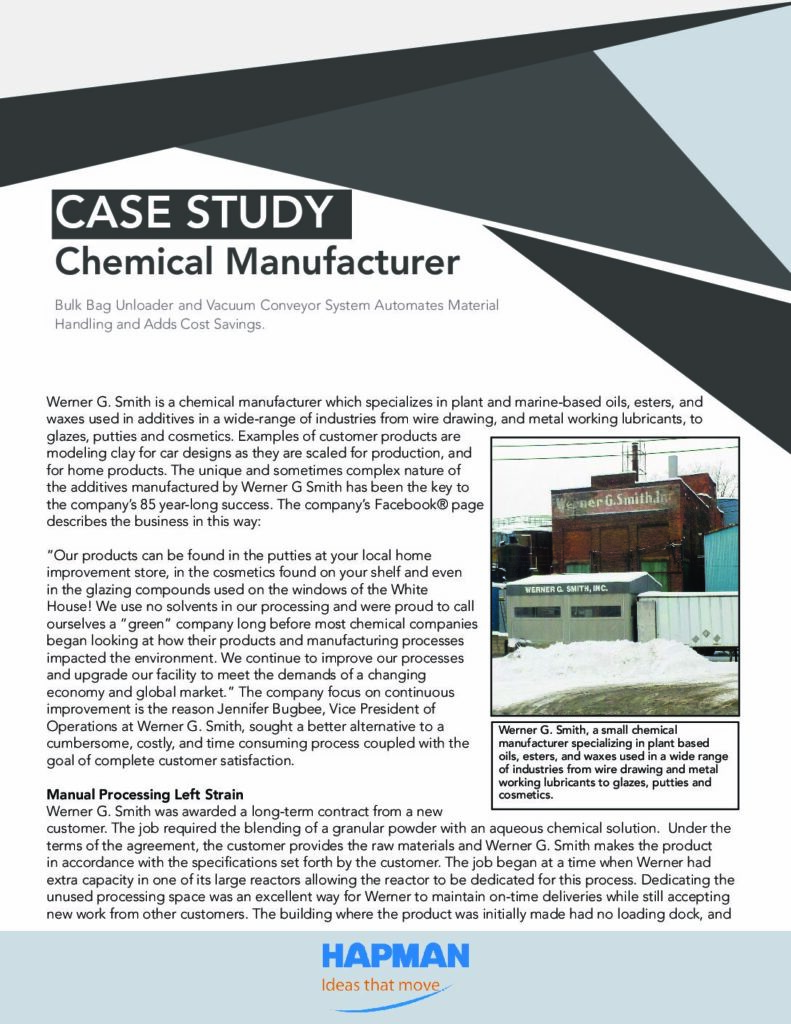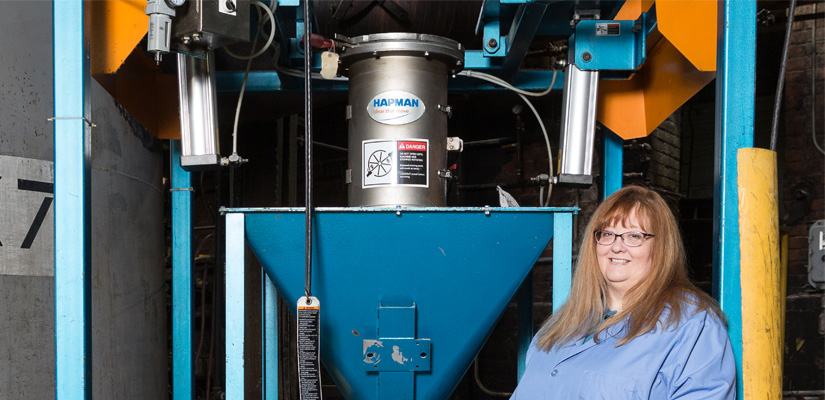
Werner G. Smith
INDUSTRY
Chemical
CHALLENGE
Werner G. Smith, Inc. was awarded a long-term contract from a new customer which required the blending of a granular powder with an aqueous chemical solution. Under the terms of the agreement, the customer would provide the raw materials and WGS would make the product in accordance with the specifications set forth in the agreement. The job began at a time when WGS had extra capacity in one of its large reactors allowing the reactor to be dedicated for this process. Dedicating the unused processing space was an excellent way for WGS to maintain on-time deliveries while still accepting new work from other customers. The building where the product was intially made had no loading dock, which meant 55 lb bags of raw material had to be hauled and processed manually.
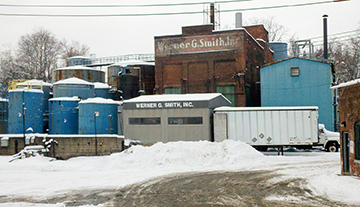 Werner G. Smith is a chemical manufacturer which specializes in plant and marine-based oils, esters, and waxes used in additives in a wide-range of industries from wire drawing, and metal working lubricants, to glazes, putties and cosmetics. Examples of customer products are modeling clay for car designs as they are scaled for production, and for home products. The unique and sometimes complex nature of the additives manufactured by Werner G Smith has been the key to the company’s 85 year-long success. The company’s Facebook® page describes the business in this way:
Werner G. Smith is a chemical manufacturer which specializes in plant and marine-based oils, esters, and waxes used in additives in a wide-range of industries from wire drawing, and metal working lubricants, to glazes, putties and cosmetics. Examples of customer products are modeling clay for car designs as they are scaled for production, and for home products. The unique and sometimes complex nature of the additives manufactured by Werner G Smith has been the key to the company’s 85 year-long success. The company’s Facebook® page describes the business in this way:
“Our products can be found in the putties at your local home improvement store, in the cosmetics found on your shelf and even in the glazing compounds used on the windows of the White House! We use no solvents in our processing and were proud to call ourselves a “green” company long before most chemical companies began looking at how their products and manufacturing processes impacted the environment. We continue to improve our processes and upgrade our facility to meet the demands of a changing economy and global market.” The company focus on continuous improvement is the reason Jennifer Bugbee, Vice President of Operations at Werner G. Smith, sought a better alternative to a cumbersome, costly, and time consuming process coupled with the goal of complete customer satisfaction.
MANUAL PROCESSING LEFT STRAIN
Werner G. Smith was awarded a long-term contract from a new customer. The job required the blending of a granular powder with an aqueous chemical solution. Under the terms of the agreement, the customer provides the raw materials and Werner G. Smith makes the product in accordance with the specifications set forth by the customer. The job began at a time when Werner had extra capacity in one of its large reactors allowing the reactor to be dedicated for this process. Dedicating the unused processing space was an excellent way for Werner to maintain on-time deliveries while still accepting new work from other customers. The building where the product was initially made had no loading dock, and would require 55 lb bags of raw material to be hauled and processed manually.
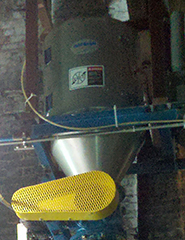 Jennifer Bugbee and her production team developed a system for handling the bags of material. The system included the use of a hand jack to load pallets holding 50 bags each into a box truck. The box truck would transport the pallets from the warehouse to the reactor building. At the reactor building five employees formed a human chain, off-loading each of the 55 lb bags from the box truck and reloading them on pallets inside the production building. The pallets where then hoisted up one story where an operator would manually pull an individual bag from the pallet, cut the bag and dump it directly into the reactor. Each batch of product took 16 hours to produce and required 200 bags of material. Werner was producing two batches per shipment at a rate of two shipments per week. This meant in one week the five employees where manually moving over 800 55 lb bags multiple times in the week. Jennifer noted, “This was an enormous waste of time and manpower and with expansion on the mind of our customer we needed to think about streamlining our process, not only to speed up manufacturing and reduce powder hazards, but to reduce the strain on an aging workforce.”
Jennifer Bugbee and her production team developed a system for handling the bags of material. The system included the use of a hand jack to load pallets holding 50 bags each into a box truck. The box truck would transport the pallets from the warehouse to the reactor building. At the reactor building five employees formed a human chain, off-loading each of the 55 lb bags from the box truck and reloading them on pallets inside the production building. The pallets where then hoisted up one story where an operator would manually pull an individual bag from the pallet, cut the bag and dump it directly into the reactor. Each batch of product took 16 hours to produce and required 200 bags of material. Werner was producing two batches per shipment at a rate of two shipments per week. This meant in one week the five employees where manually moving over 800 55 lb bags multiple times in the week. Jennifer noted, “This was an enormous waste of time and manpower and with expansion on the mind of our customer we needed to think about streamlining our process, not only to speed up manufacturing and reduce powder hazards, but to reduce the strain on an aging workforce.”
AUTOMATION IMPROVES OPERATIONS AND EMPLOYEE HEALTH
Jennifer needed to find resources to help her design a new material handling system. She understood the manual handling of their bulk material was hurting operations from both a material cost and employee safety stance; however, finding the time to research the best alternatives was daunting given her normal day-to-day work load. Jennifer reached out to a local industrial supplier, Powell Equipment Company. Jeff Powell met with Jennifer at the facility to see the current operating situation first hand. Jeff quickly assessed that the manufacturer he needed to contact for this project was Hapman. Jennifer spoke with Steve Grant, Hapman Vacuum conveyor Product Manager, to explain her operating conditions and her goals for improvement. Steve worked with Jennifer to fully understand the details of the application and the material that needed to be handled. Steve requested information such as material type and required flow rate, temperature, flowability, particle size, moisture content, and material contact surface requirements. Also important information asked was the horizontal and vertical distance required, existing plant layout, and existing controls automation. Compiling all of the details from Jennifer, Steve made a full recommendation to improve the bulk material handling in her facility.
THE COMPLETE SYSTEM PAYS BACK
The foundation of material characteristics and flow dynamics goes into the design of each piece of Hapman equipment. The Hapman knowledge and experience worked to provide Werner G. Smith with new equipment that achieved the company goals of increasing productivity, decreasing operating costs and improving worker safety. Process manufacturers of all types also evaluate capital equipment purchases based on total cost of ownership (Figure 1). These factors vary from one industry to another; however the goal is the same, to make an investment in equipment that adds to the bottom line over the long term.
The system recommend by Hapman consisted of a Lossin- Weight Bulk Bag Unloader with a vacuum conveyor. The equipment worked together, automatically moving material from unload to process. The details of the system included:
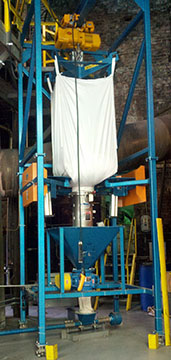 Bulk Bag Unloader:
Bulk Bag Unloader:
- Hoist and Trolley Bulk Bag Unloader with loss in-weight measurement – Provided for consistent feeding of material to the downstream conveyor.
- Automatic Bag Agitator Assembly – This assembly will keep compacted material flowing smoothly and evenly and includes an air operated control panel and air cylinder operated bag agitator paddles. Controls provide a simultaneous paddle stroke for optimum bag massaging.
- Bag Spout Access Chamber – Includes the side access door and top inlet opening for bag spout.
The bulk bag unloader fed the Vacuum Conveying system, which included:
- Vacuum Conveying System
- Carbon steel filter/receiver housing – Designed for longevity and ease of use, with slide gate, and quick release side access door for tool-less filter change over.
- Safety Features – Safety interlock switch to shut down system if side access door is opened
- Integral Micron Filter – Filter with a 99.99% efficient rating down to 0.5 micron.
- Reverse air pulse filter cleaning mechanism – Keeps filter clean and system running at optimum operating efficiency.
- Integral regenerative vacuum blower assembly – Complete with exhaust silencer
- Surge Capacity – Eight cubic foot surge hopper provided optimum capacity and minimized operator monitoring.
- Batch Controls – Integral control panel to operate the entire system automatically or manually, fault alerts, and safety shut-off, VFD relays, NEMA 4X rating, load cell readout and diverter control for future expansion.
Each of the Hapman components worked together as a complete system, automating most of the material handling process while improving production time and quality.
PROVEN RESULTS – POSITIVE RETURN
After purchasing and installation of the Hapman bulk material handling system, the returns to Werner G. Smith were almost immediate. The cost savings began with the elimination of the need to have a third party supplier break down larger bags of raw material into the 55 lb bags so Werner employees could manually handle them. The elimination of this step automatically dropped the cost per unit for Werner’s customer. The five employees were assigned duties directly related to production rather than wasting time manually unloading pallets of 55 lb. bags. This change improved production time by several hours. In addition Werner improved overall housekeeping within the facility because bags of material were emptied in an enclosed system and the new process eliminated 80% of the bag waste they had been generating.
